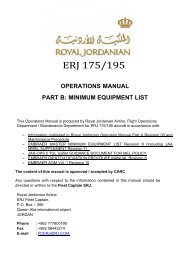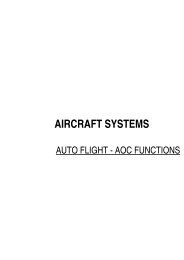Create successful ePaper yourself
Turn your PDF publications into a flip-book with our unique Google optimized e-Paper software.
A330/A340<br />
FLIGHT CREW<br />
OPERATING MANUAL<br />
<strong>AIRCRAFT</strong> <strong>SYSTEMS</strong><br />
AUTO FLIGHT - FLIGHT GUIDANCE<br />
AUTOTHRUST<br />
the aircraft is maintained above a minimum level, ensuring standard aerodynamic margins versus<br />
stall.<br />
If the A/THR is active in SPEED mode, it will automatically follow the speed target, ensuring<br />
efficient thrust management during the approach.<br />
The minimum energy level is the energy level the aircraft will have at touchdown, if it lands at<br />
VAPP speed with the Tower-reported wind as inserted in the PERF APPR page. The minimum<br />
energy level is represented by the Ground Speed the aircraft will have at touchdown. This Ground<br />
Speed is called "GROUND SPD MINI".<br />
During the approach, the FMGES continuously computes the speed target using the wind<br />
experienced by the aircraft in order to keep the ground speed at, or above, the “Ground Speed<br />
Mini”.<br />
The lowest speed target is lower limited to VAPP, and is upper limited to VFE of next configuration<br />
in CONF 1, 2, 3 and VFE-5 in CONF FULL.<br />
The speed target is displayed on the PFD speed scale in magenta when approach phase and<br />
managed speed are active. It is independent of the AP/FD and/or ATHR engagements.<br />
Wind is a key factor in the ground speed mini function.<br />
TWR WIND<br />
TWR WIND is the MAG WIND entered in the PERF APPR page. It is the average wind provided<br />
by the ATIS or the Tower. Gusts must not be inserted, they are included in the aircraft target<br />
speed computation.<br />
TWR HEADWIND COMPONENT<br />
The TWR HEADWIND COMPONENT is the component of the TWR wind projected on the runway<br />
axis (landing runway entered in the flight plan). It is used to compute VAPP and GS mini.<br />
CURRENT HEADWIND COMPONENT<br />
The actual wind measured by ADIRS is projected on the aircraft axis to define the CURRENT<br />
HEADWIND COMPONENT (instantaneous headwind).<br />
The CURRENT HEADWIND COMPONENT is used to compute the variable speed target during<br />
final (IAS target).<br />
VAPP COMPUTATION<br />
VAPP, automatically displayed on the MCDU PERF APPR page, is computed as follows:<br />
‐ VAPP = VLS+1/3 of the TWR HEADWIND COMPONENT, or<br />
‐ VAPP = VLS+5 kt, whichever is the highest.<br />
RJA A330/A340 FLEET DSC-22_30-90 P 17/22<br />
FCOM ← I → 03 MAY 11






